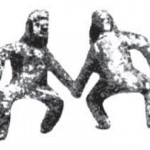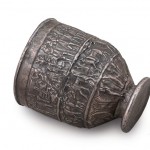Studies of the monuments of material culture, discovered during archaeological excavations, and written sources have shown that Georgian musical culture is about three thousand years old.
In 1930 a bone salamuri (flute) was found together with other things in ancient burials of Samtavro in Mtskheta. Supposedly they date back to the 15th-13th centuries B.C.
In the 1970s the drawings of ancient instruments bobghani, knari and changi, dating to 11th-10th centuries B. C., were discovered in Qazbegi. It is noteworthy that changi resembles the instrument depicted on a Sumerian bas-relief (third millenium B.C.).
Ancient origin of Georgian folk music is also proved by the archaic samples of metal work, including a silver bowl from Trialeti (middle of the 3rd
Silver bowl from Trialeti depicts the syncretic activity Perkhuli, dedicated to the ancient Goddess of fertility. The traces of such rituals have reached us through a number of perkhuli (round-dance) songs (Adrekilai, Sakmisai, Mmelia Telepiai, etc.), regarded as one of the most archaic forms of Georgian music.millenium B.C.), a bronze belt from Samtavro (the 8th-7th centuries B.C.) and bronze sculptures known as ”Qazbegi Treasure” (the 7th-6th centuries B.C.).
The oldest Example of Georgian choreography – dance of hunters, performed during the new Moon, is engraved on the bronze belt from Samtavro. This very detail points to the trace of ancient religious concepts: the Moon held the supreme place in the pantheon of Georgian pagan deities. Dances and songs in the moonlight are still maintained in different parts of Georgia (women’s ritual hymn Dideba in Kartli and Kakheti, Svan round dances Shushpari, Monadireta Tsekva, etc.).
The ”Qazbegi Treasure” is a burch of bronze figures. According to some scholars they are artistic incarnation of the ancient Georgian epic monument Amiraniani. Each sculpture carries a certain dramatic function and corresponds to the logical development of the plot of Amiraniani.
Apart from the materials found by archaeologists, there are also written sources telling about the historical roots of Georgian music.
In one of the ancient sources from the 8th century B.C., after having conquered Mana, one of the Urartian regions populated by Georgians (714 B.C.) Assyrian king Sargon describes with admiration high cultural level and luxury of the native people. He specifically mentions the fact that Mana people facilitated their work and cheered themselves in work process by their ”joyous songs”. Although the source does not refer to the musical side of the songs, it is clear that they must have been labour songs.
With the adoption of Christianity in the 4th century, foundation was laid for sacred music, though historical sources about this fact date back to the 6th-7th centuries. Namely, the will of Sabas the Sanctified (died in 532) and Giorgi Merchule’s The Life of Grigol Khandzteli confirm that in the 6h – 7th centuries the divine service at Georgian church was performed in Georgian language. The Life of Grigol Khandzteli tells that chanting was taught at Georgian churches in the 9th century. The works by famous hymnographers of the 9th-11th centuries – Ioane Minchkhi, Ioane Mtbevari, Ezra, Kurdanai, Ekvtime and Giorgi Mtatsmindeli, Catholicos Ioane, Arsen Iqaltoeli, Ioane Zosime and many others, tell that Georgian chanting had reached the pinnacle of its development by that time. In 978-988 Mikael Modrekili, one of the most distinguished hymnographers, compiled transcriptions of Georgian chants in neumatic notation in the book Iadgari (Tripologion). The book contains works by Georgian hymnographers of the 8th-10th centuries. The so called Tsvirmuli and Ieluri manuscripts, neumatic collections of Alaverdi Hirmos, allegedly collected by monk Iordane, and the so called Pitaretis Krebuli (selection of works from Pitareti) that has reached us as the 18th century manuscript, date to the 10th-11th centuries. These hymn-books convey information both on chanting tradition and development of musical notation in the 9th-11th centuries. Xenophon’s (Greek historian of the 4th century B.C.) ”Anabasis” tells about the battle of the Georgians’ distant ancestors Mossynoeci: ”. . . After having lined up, one of them started a song and all others followed marching and singing rhythmically”. After the battle ”they cut off the heads of the slain, and performed songs and dances of peculiar kind”. What Xenophon interprets as ”peculiar”, different from Greek, cannot be scientifically specified; some scholars are of the opinion that the impression of ”peculiarity” could have been made by multi-voiced singing. But one is obvious: in those remote times the Georgians had war songs and dances; one performer would start and others would join.
 Ganmartebai Proklesatuis Diadokhosisa Da Platonurisa Pilosopiisatuis (The Considerations on Proclus Diadochus and Platonic Phylosophy), written by the 11th century theo-philosopher Ioane Petritsi, can be regarded as the historical source of remarkable significance. In the conclusion of the book we find very important musical analogies. Here the Georgian names for the three voices mzakhr, zhir andbam are mentioned for the first time. The author likens these three voices to the Holy Trinity.Georgia’s political and cultural life flourished in the 11th-12th centuries. Kartlis Tskhovreba (Life of Kartli, the chronicle of Georgian history) and works by famous Georgian poets Shota Rustaveli, Ioane Shavteli, Chakhrukhadze, Mose Khoneli, Sargis Tmogveli and others tell that music was one of the most widespread branches of art in those days. It was heard everywhere; court singers recited poems and odes with the accompaniment of wind, string and percussion instruments; hunting, battles, mourning, weddings and festivals were accompanied by music. The abundance of terms for voice parts and the names of instruments found in the literary monuments of the time speak of the high level of Georgian multi-voiced vocal and instrumental music.
Ganmartebai Proklesatuis Diadokhosisa Da Platonurisa Pilosopiisatuis (The Considerations on Proclus Diadochus and Platonic Phylosophy), written by the 11th century theo-philosopher Ioane Petritsi, can be regarded as the historical source of remarkable significance. In the conclusion of the book we find very important musical analogies. Here the Georgian names for the three voices mzakhr, zhir andbam are mentioned for the first time. The author likens these three voices to the Holy Trinity.Georgia’s political and cultural life flourished in the 11th-12th centuries. Kartlis Tskhovreba (Life of Kartli, the chronicle of Georgian history) and works by famous Georgian poets Shota Rustaveli, Ioane Shavteli, Chakhrukhadze, Mose Khoneli, Sargis Tmogveli and others tell that music was one of the most widespread branches of art in those days. It was heard everywhere; court singers recited poems and odes with the accompaniment of wind, string and percussion instruments; hunting, battles, mourning, weddings and festivals were accompanied by music. The abundance of terms for voice parts and the names of instruments found in the literary monuments of the time speak of the high level of Georgian multi-voiced vocal and instrumental music.
From the 13th century the Mongols and other invaders started raiding Georgia. Unfortunately we do not have any significant musical, historical and literary material of that period.
In the 17th century Persian hegemony began in Georgia. Persian literature and music was heard at the King’s court. Famous French traveler Chardin writes about this. During his visit to Georgia he attended a wedding ceremony at the palace of King Vakhtang V. He describes that at the wedding the traditions and music were Persian. Apparently he had no information about Georgian traditional music, due to the circumstances mentioned above.
At the turn of the 18 th century political and literary activities of Georgian kings Archil II, Vakhtang VI and Teimuraz II were of great importance for Georgian culture. Their works serve as historical sources on the musical culture of that period, for they tell about various Georgian songs and instruments as well as about the rituals connected with music in general. In this respect Archil’s Dghisa Da Ghamisa Gabaaseba (Conversation between Day and Night) and Sarke Tkmulta (The Mirror of the Told), are very interesting. Sulkhan-Saba Orbeliani, a Georgian scholar, lexicographer, writer and public figure contributed greatly to the development of Georgian musical art. His dictionary Sitqvis Kona (Bunch of Words) contains many valuable sources on Georgian music and musical terminology. It is a handbook for Music Historians. Vakhushti Batonishvili’s encyclopaedic work Sakartvelos Georgapia (Geography of Georgia) also contains interesting information about the musical culture of that period.
Kalmasoba and Musikis Sakhelmdzghvanelo (Music Manual) by Ioane Batonishvili, a versatile Georgian statesman at the beginning of the 19th century also worth mentioning. The latter has reached us in fragments, but Kalmasoba is a comprehensive encyclopaedia of those times, in which the author discusses the issues on secular and sacred music, the structure of Georgian choir, etc. He also provides interesting material about Georgian musicians of ancient times.
From the second half of the 19th century the revival of national culture began in Georgia. The interest towards folk music gradually increased. The restoration and notation of Georgian church hymns and folk songs, intended to implant them in the society, was started. Kartvelta Zneoba (the Morality of the Georgians) by Davit Machabeli, eminent musician, scholar, poet, writer, musicologist and public figure, is dedicated to the revelation of the basic issues on Georgian chant. The author’s explanations are still regarded as excellent.
In 1860 the ”Committee for the Revival of Georgian Chant” was founded in Tbilisi. It aimed to transcribe and publish church hymns and to popularize them with the help of choirs of chanters. Articles written by Alexandre Jambakur-Orbeliani, Bishop Alexandre, Pilimon Koridze, Anton Dumbadze, introductions to the collections of hymns and manuscripts written by Vasili and Polievktos Karbelashvili, Razhden Khundadze, Ekvtime Kereselidze and other musicians and church figures of that time, who took responsibility for the revival of ancient traditional musical culture, serve as historical sources. They give valuable information on the history of Georgian chant and its contemporary condition.
The foundation for the studys of Georgian folk music was laid at the end of the 19th century.





